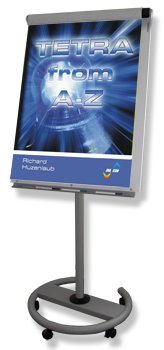 TETRA from A-Z
TETRA from A-Z
[2-day course, Euro 2,350.- (net) per participant]
 Training Course Description
Training Course Description

- This training course addresses the needs of engineers and technicians who are involved in the design, development and operation of TETRA networks and solutions and need to understand the architecture and implementation options.
- The training course starts with an overview of Terrestrial Trunked Radio solutions and secure authority signaling environments such as Police, Fire Departments, Rescue and Emergency Services and other Public Safety Forces.
- We will clarify the different terms and definitions and the distinction, such as TETRAPOL, BOS, FMT and identify the scope of TETRA and the migration from analogue emergency radio technology to digital trunked radio, including a short system comparison.
- The second part of the training course will focus on the architecture details with base stations, network control functions, gateways to public communication systems and the different types of terminals, analogue and digital pagers and phone / pager combinations.
- The basic operational modes, trunked mode and DMO will be discussed in detail, also the network and mobility management functions. This includes the details of the TETRA protocol stack with a PHY and MAC layer overview, higher layer control plane entity details and the user plane functionality.
- TETRA interworking with IP networks, IPI and ToIP, TETRA data service, voice coding with ACELP and a comparison with GSM / GPRS and future outlook on possible convergence will conclude this section.
- We then have a in depth review of the TETRA air interface with TDMA frame structuring, channel mappings, modulation and FEC schemes. The MAC and LLC structure and the PDU types including the mapping from application to the physical transport will be evaluated in detail.
- Identification of TETRA identities and the addressing scheme together with a comparison to public mobile communication systems will finalize the system understanding.
- The TETRA security architecture is then evaluated with the air interface authentication and encryption and the key management mechanisms, such as OTAR protocol and the use of cipher keys.
- The training course will then sum up the technology with the discussion of selected call scenarios for individual circuit mode and group voice calls with the focus on call setup and call clearing. .
 Some of your questions that will be answered
Some of your questions that will be answered
- What is TETRA, TETRAPOL, BOS, FMT and how do these systems interwork?
- Who is involved in the standardization of TETRA and what is the role of TETRA MoU?
- Which are the voice and data features supported by TETRA??
- What does the protocol stack for TETRA service look like and how does it compare to public Mobile Systems such as GSM and GPRS?
- What is the possible TETRA evolution towards 3G / UMTS?
- Which logical and physical channels are defined for TETRA and how do they map to the physical transport?
- Why is TDMA being used for TETRA rather than FDMA?
- What are the modulation and FEC schemes and what is their benefit?
- How does mutual authentication and air interface encryption work in TETRA, what are the protocols, security classes and keys used?
- How does the call setup and call clearing work and compare to e.g. GSM?
 Who should attend this class?
Who should attend this class?
- The training course is particular useful to design engineers and technicians who are involved in the design, implementation and operation of TETRA networks and solutions.
- Network operators, security and technical staff who need understand the TECTRA communication environment, the technical basis and signaling options.
- Everybody who requires detailed knowledge about the TETRA signaling mechanisms.
 Pre-Requisites
Pre-Requisites
- The student should possess basic technical understanding of Mobile Communication technologies, such as GSM and GPRS.
- A general understanding of physical layer coding, modulation schemes and multiplexing technologies would be helpful.
 Training Course Target
Training Course Target
After the training course, the student will be able to:
- Deeply understand the TETRA architecture and the benefits for emergency communication and secure alarm signaling between different public authorities.
- Provide a detailed comparison between the TETRA system and public mobile network systems such as GSM.
- Explain the TETRA radio interface specifics in detail, identify the channel structure and their mapping to physical resources and describe the flow of signaling and data PDUs through the protocol layers.
- Understand and apply the TETRA addressing schemes and use of identifiers.
- Understand the TETRA authentication and encryption methods, the key handling and provision and can provide detailed comparison to public mobile network authentication and encryption.
- Identify and list the different type of TETRA services and their application.
 Training Course Duration
Training Course Duration
- 2 days
v0.100
ℹ️ Try out the updated search below!
Search:
More Info:
Detailed ToC of this course
Schedule of this training course
INACON eBooks
Please have a look at our full offer

